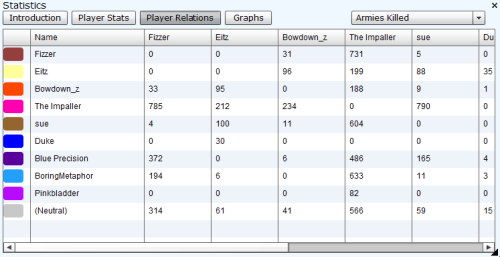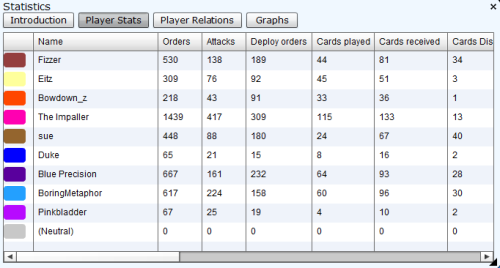Statistics Window
The statistics window shows you a variety of interesting information about the game. It's divided into three sections: Graphs, relations between players, and player statistics.
The statistics window can't see anything that you couldn't tell from digging through the history. This means it can't see through the fog of on-going games or anything like that - it's just used more easily collect the data that's already available to you.
Graphs
The graphs allow you to see information about a game in graphical form.

You can view the following metrics on the graph:
- The number of armies on the map.
- The number of territories held by each player.
- The base number of armies each player receives per turn.
- The actual number of armies each player deployed each turn.
- The cumulative offensive luck value for each player.
- The cumulative defensive luck value for each player.
- The cumulative luck value (offensive + defensive) for each player.
Relations between Players
The "relations" tab shows how much each player has fought with other players. It’s great for determining who has been fighting who.

It can be switched between the following metrics:
- The number of A's armies killed in fights between player A and B.
- The number of A's armies killed in A's attacks against B.
- The number of B's armies killed in A's attacks against B.
- The number of armies that A defended with against B's attacks.
- The number of armies that A attacked with against B.
- If you hover your mouse over a cell, WarLight will show you a description of what that cell represents.
Player statistics
The player stats tab shows a variety of statistics about each player.

It shows the following metrics:
- Total number of orders issued.
- Total number of attacks issued.
- Total number of deployments issued.
- Total number of cards played.
- Total number of cards received.
- Total number of cards discarded.
- Total number of transfers.
- Total number of successful attacks. (territory captures)
- Total number of failed attacks.
- Total number of armies attacked with.
- Total number of armies lost by attacking.
- Total number of armies killed by attacking. (defending armies killed)
- Total number of armies transfers.
- Total number of armies deployed.
- Total number of times attacked.
- Total number of armies that attacked this player.
- Total number of armies killed while defending. (attacking armies killed)
- Total number of armies lost while defending.
Luck Values
It's important to understand what the luck numbers represent before drawing conclusions based on them.
Here's an example: If you attack with 10 armies, it's expected that you will kill 6 armies. If you kill 7, your luck for that attack will be +1. In other words, you killed exactly one army more than you were supposed to. You can view the luck number for any attack by hovering over it in the Turn Actions panel when viewing history.
"Offensive" luck simply means the sum of the luck for all attacks you issued. "Defensive" luck simply means the sum of the luck for all attacks another player issued against your armies. Your total "luck" is simply your offensive luck plus your defensive luck.
So if you see a luck of +50, it means that player has 50 more armies than they "should" have had at that point in the game. Similarly, a luck of -15 means that the player has 15 fewer armies than they would have had if luck was not involved.
If you wish to reduce the amount that luck affects the game, you can always do so by using the luck modifier.